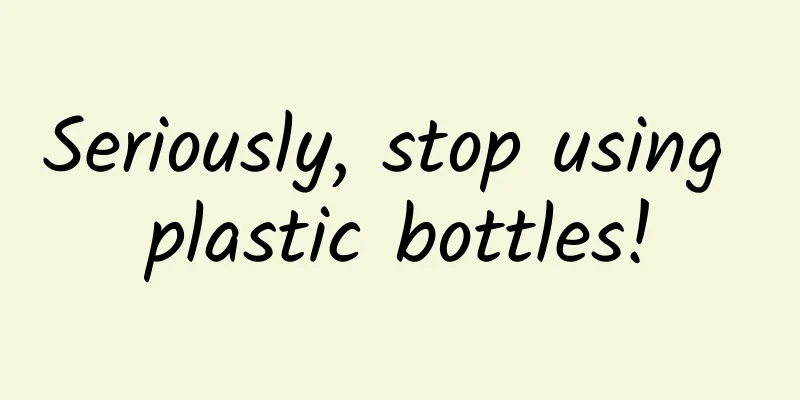Seriously, stop using plastic bottles!

|
Many elders have this habit: no matter whether it is a beverage bottle or a mineral water bottle, they will wash it clean, tear off the label and use it for storage. For example, small beverage bottles are used to store condiments such as soy sauce and vinegar, and large beverage bottles are used to store rice, noodles, grain, oil, etc. If you walk into the kitchens of many elders, you can see many similar "waste utilization" of plastic bottles. This seems to be a good thing for the environment and saving money, but what many people don’t know is that using plastic bottles to store food for a long time actually poses significant health risks. Various plastic bottles in my parents’ kitchen, Image source: Linlin Why is it not recommended to reuse beverage bottles and mineral water bottles? In our lives, plastic products can be found everywhere. From small bottles and cans to large furniture and building materials, you can find no less than ten kinds of plastic products if you just stand up and walk around. Although they are all plastic, there are actually differences between plastic products. On plastic products, we can usually find a triangular arrow sign, and the plastic in the triangle ranges from 1 to 7, representing the specifications of their raw material resin. Copyright images in the gallery. Reprinting and using them may lead to copyright disputes. Different grades of plastic products have different characteristics and application scenarios. Most of the plastic products we come into contact with are usually made of non-reusable No. 1 PET material, namely polyethylene terephthalate. For example, beverage bottles, mineral water bottles, various disposable packaging bags, packaging boxes, plastic seals, etc. that our elders like to use are basically PET. This material is light, odorless, chemically stable, and airtight. It can be directly used for food packaging and is the most widely used beverage packaging material. Copyright images in the gallery. Reprinting and using them may lead to copyright disputes. As long as PET plastic products on the market comply with national standards and meet storage conditions and storage cycles, the migration of harmful substances needs to be lower than the standard amount and will not pose a health risk to the human body. But be aware that if you reuse, change the contents of a plastic bottle, or store it in unsuitable conditions, it is likely to become unsafe. 1 Changing what is contained may pose a safety risk Beverage bottles, mineral water bottles, etc. are designed and produced mainly for liquids such as water, carbonated drinks, juice, and tea. If they are used to hold other liquids, the release of toxic substances may become faster and more frequent due to changes in the properties of the liquid. For example, if you put vinegar in a beverage bottle, the pH value of the liquid will decrease, which is likely to increase the migration of harmful substances. Studies have found that when PET plastic bottles are used to hold 4% acetic acid, 10% ethanol, and 20% ethanol, the migration amount of the harmful substance antimony in the bottles containing acetic acid is significantly higher than that of the other two. 2 High temperatures can make beverage bottles unsafe PET is not resistant to high temperatures and cannot be used to hold food or hot water above 70 degrees. If overheated food is contained, it will deform and release harmful substances that are harmful to human health. Some people use beverage bottles or mineral water bottles to pack cooking oil and place them around stoves, which is highly not recommended. High temperature environments will dramatically increase the migration and diffusion of harmful substances in beverage bottles, posing health risks. 3 Drink bottles age, posing health risks We know that bottled water/beverages have a shelf life, which is not only the limit of the flavor and quality of the beverage itself, but also the shelf life of the plastic bottle itself. This is because PET itself will age due to long-term use, which will lead to an increase in the migration of harmful substances. Some elders use plastic beverage bottles to store rice, millet, red beans, seasonings and other foods, and they use them for half a year or even several years without replacing them. Not to mention, some people put it next to the stove, which greatly increases the risk. My parents' kitchen has been using plastic bottles for more than half a year. Image source: Lin Lin How much harm do the migrated harmful substances do to the human body? The harmful substances released from PET plastic bottles such as beverage bottles and mineral water bottles during use can be roughly divided into two categories: 1 Antimony metal catalyst used in the production process Antimony is biologically toxic and can enter the human body through the skin, digestive tract, etc., causing damage to tissues or organs such as the skin, heart, liver, and kidneys. Although small doses of antimony have no obvious effect on the human body, it has a certain accumulation effect. Long-term chronic intake will cause irreversible damage to various organs and systems of the human body. 2 Other organic matter In order to increase the durability and strength of PET, plasticizers represented by phthalates (PAEs) are usually added during the production process. This plasticizer can disrupt the human endocrine system, increase the risk of cancer, and pose potential health risks. Try to avoid exposure to it as much as possible. Copyright images in the gallery. Reprinting and using them may lead to copyright disputes. How to use plastic products correctly? Plastic is almost irreplaceable in our lives. In addition to common beverage bottles and mineral water bottles, people also buy some plastic storage cans to hold food. Different plastics have different precautions when used to hold food. When using, only by following the instructions, such as the use temperature, the type of items, whether it can be reused, etc., can safety and no health risks be guaranteed. Plastic products have a triangular arrow sign with a number in the middle, indicating the material. This is a copyrighted image from the gallery. Reprinting and using this image may result in copyright disputes. In addition to "PET No. 1", we have also compiled several other types of plastics that we often come into contact with in daily life and their usage precautions for your reference. No. 2 HDPE High-density polyethylene It has a slightly higher tolerance to high temperatures and can withstand temperatures of 110 degrees. In addition to being made into plastic bags and plastic barrels, it is often used as pipes, doors and windows, fiber products, hollow containers, films, and injection molding products in buildings. HDPE also releases harmful substances over long-term use and is therefore not recommended for food storage. PVC No. 3 Polyvinyl chloride There are two types: hard and soft, usually used in daily necessities, such as plastic gloves, plastic sheets, daily necessities plastic bottles, etc. It should be noted that some low-quality cling film also uses PVC materials, which are not suitable for high-temperature heating. No. 4 LDPE Low density polyethylene Common ones include plastic wrap, sealed bags, etc., which can withstand temperatures around 90 degrees, but harmful substances may be released when the temperature exceeds 110 degrees, so it is not recommended to store high-temperature food . PP No.5 Polypropylene If you are used to packing food in plastic boxes, you can buy PP plastic boxes that meet the standards. Microwave lunch boxes and baby bottles made of PP plastic are resistant to high temperatures and can hold hot water, hot food, etc. PP material is also the only material among all plastics that can be heated in a microwave oven. It should be noted that some microwave-safe lunch boxes have a body made of microwave-safe No. 5 PP material, but the lid may be made of a non-microwave-safe material. Therefore, the lid needs to be removed when heating, otherwise harmful substances will be released. PS No. 6 Polystyrene It is mainly used in disposable tableware, biscuit boxes, stationery, etc. It has poor heat resistance and is not recommended for storing high-temperature food and repeated use. PC No. 7 Polycarbonate It can be used to make reusable water bottles, milk bottles, etc., and can also be used to make daily necessities such as buckets, suitcases, etc. PC material is acid-resistant, but not resistant to oil, ultraviolet rays, strong alkali, etc. It is not microwave-resistant and is not suitable for storing kitchen seasonings. Planning and production Author: Hydra popular science creator Review | Dong Wenjun Professor of School of Materials Science and Engineering, University of Science and Technology Beijing Planning丨Lin Yiyi Editor: Lin Lin |
<<: 3D simulation technology: a magical power to change the world
>>: Nature: AI is so useful that it makes people too arrogant
Recommend
How much does it cost to customize a nutritional product mini program in Ganzi?
The main factors affecting the price of mini prog...
School is suspended but classes are not! Students across the country take classes online! Post a set-top box version (Juhaoxue) to learn on TV_Resource headlines
There are many wonderful animations such as child...
Is it expensive to make the Qamdo appointment registration mini program? The cost and process of making a Qamdo appointment registration app
There is no doubt that the topic of mini programs...
The latest policy on rural car subsidies in 2022: When will it start? How much subsidy is there for each car?
In recent years, due to the impact of the COVID-1...
2020 Marketing Trend Prediction
It seems that every year, articles reviewing mark...
Looking back at 2015 and looking forward to 2016, what progress has been made in the field of machine learning?
[[160860]] A few decades ago, artificial intellig...
OPPO Reno6 Pro review: Put the summer sea in your pocket, a real "dessert" phone for young people
In OPPO's mobile phone product line, the Reno...
Practical tips: How to promote an event well?
First, let me give you a few tips: Tip 1: How to ...
Elon Musk's "AI Demon Theory" is slandering the industry!
[[122220]] Translation/Chilongfei, Yang Hanshu, V...
Human body "power plant"? Stable output for 5 months, easily lighting up 100 LED lights
Currently, as the product innovation of smartphon...
How can an app push activities based on user information?
According to statistics, a precisely pushed campa...
High retention methods for acquiring customers by e-commerce platforms such as Pinduoduo!
Speaking of social games, most people may think o...
Zui Yoga Elite Instructor Group Zero-Based Yoga Instructor Training Preparatory Class (with notes)
Introduction to the resources of the Drunk Yoga E...
Black holes also come in pairs? The heaviest supermassive black hole pair ever discovered!
Using archival data from the Gemini North telesco...
What are some side jobs suitable for office workers? What other side jobs can you do while working?
With the continuous development of technology, pe...









